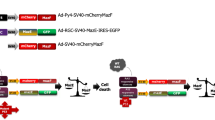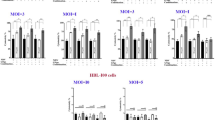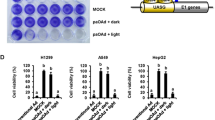Abstract
Cancer gene therapy using tumor suppressor genes is considered to be an attractive approach for arresting cell growth and inducing apoptosis. Programmed cell death 4 (Pdcd4) is a tumor suppressor gene, which prevents tumorigenesis and tumor progression. To address the issue of whether expression of PDCD4 protein induces apoptosis in cancerous cells, the Pdcd4 gene was delivered using folate-PEG-baculovirus. Folate-PEG-baculovirus containing Pdcd4 gene (F-P-Bac-Pdcd4) was constructed by attachment of F-PEG to the baculovirus surface using chemical modification. The F-P-Bac-Pdcd4 showed enhanced transduction efficiency, efficiently expressed PDCD4 protein, and induced apoptosis in human epidermal carcinoma (KB) cells as compared with an unmodified baculovirus. In a tumor xenograft study, injection of F-P-Bac-Pdcd4 into tumors established from the KB cell line by subcutaneous implantation significantly suppressed tumor growth and induced apoptosis. Thus, this study shows a new baculovirus-mediated tumor suppressor gene delivery system for cancer therapy.
This is a preview of subscription content, access via your institution
Access options
Subscribe to this journal
Receive 12 print issues and online access
$259.00 per year
only $21.58 per issue
Buy this article
- Purchase on Springer Link
- Instant access to full article PDF
Prices may be subject to local taxes which are calculated during checkout







Similar content being viewed by others
Abbreviations
- FR:
-
folate receptor
- KB cells:
-
human epidermal carcinoma cells
- PBS:
-
phosphate buffered saline
- Pdcd4:
-
programmed cell death 4
References
Guo ZS, Li Q, Bartlett DL, Yang JY, Fang B . Gene transfer: the challenge of regulated gene expression. Trends Mol Med 2008; 14: 410–418.
Yang ZR, Wang HF, Zhao J, Peng YY, Wang J, Guinn BA et al. Recent developments in the use of adenoviruses and immunotoxins in cancer gene therapy. Cancer Gene Ther 2007; 14: 599–615.
Edelstein ML, Abedi MR, Wixon J, Edelstein RM . Gene therapy clinical trials worldwide. J Gene Med 2004; 6: 597–602.
Ponnazhagan S, Curiel DT, Shaw DR, Alvarez RD, Siegal GP . Adeno-associated virus for cancer gene therapy. Cancer Res 2001; 61: 6313–6321.
Hughes RM . Strategies for cancer gene therapy. J Surg Oncol 2004; 85: 28–35.
Roth JA, Nguyen D, Lawrence DD, Kemp BL, Carrasco CH, Ferson DZ et al. Retrovirus-mediated wild-type p53 gene transfer to tumors of patients with lung cancer. Nat Med 1996; 2: 985–991.
Peng Z . Current status of gendicine in China: recombinant human Ad-p53 agent for treatment of cancers. Hum Gene Ther 2005; 16: 1016–1027.
Fueyo J, Gomez-Manzano C, Yung WK, Liu TJ, Alemany R, Bruner JM et al. Suppression of human glioma growth by adenovirus-mediated Rb gene transfer. Neurology 1998; 50: 1307–1315.
Minaguchi T, Mori T, Kanamori Y, Matsushima M, Yoshikawa H, Taketani Y et al. Growth suppression of human ovarian cancer cells by adenovirus-mediated transfer of the PTEN gene. Cancer Res 1999; 59: 6063–6067.
Yang HS, Jansen AP, Komar AA, Zheng X, Merrick WC, Costes S et al. The transformation suppressor Pdcd4 is a novel eukaryotic translation initiation factor 4A binding protein that inhibits translation. Mol Cell Biol 2003; 23: 26–37.
Jansen AP, Camalier CE, Colburn NH . Epidermal expression of the translation inhibitor programmed cell death 4 suppresses tumorigenesis. Cancer Res 2005; 65: 6034–6041.
Wang Q, Sun Z, Yang HS . Downregulation of tumor suppressor Pdcd4 promotes invasion and activates both beta-catenin/Tcf and AP-1-dependent transcription in colon carcinoma cells. Oncogene 2008; 27: 1527–1535.
Lankat-Buttgereit B, Goke R . The tumour suppressor Pdcd4: recent advances in the elucidation of function and regulation. Biol Cell 2009; 101: 309–317.
Afonja O, Juste D, Das S, Matsuhashi S, Samuels HH . Induction of PDCD4 tumor suppressor gene expression by RAR agonists, antiestrogen and HER-2/neu antagonist in breast cancer cells. Evidence for a role in apoptosis. Oncogene 2004; 23: 8135–8145.
Jin H, Kim TH, Hwang SK, Chang SH, Kim HW, Anderson HK et al. Aerosol delivery of urocanic acid-modified chitosan/programmed cell death 4 complex regulated apoptosis, cell cycle, and angiogenesis in lungs of K-ras null mice. Mol Cancer Ther 2006; 5: 1041–1049.
Kim YK, Choi JY, Yoo MK, Jiang HL, Arote R, Je YH et al. Receptor-mediated gene delivery by folate-PEG-baculovirus in vitro. J Biotechnol 2007; 131: 353–361.
Kim YK, Park IK, Jiang HL, Choi JY, Je YH, Jin H et al. Regulation of transduction efficiency by pegylation of baculovirus vector in vitro and in vivo. J Biotechnol 2006; 125: 104–109.
Pan XQ, Wang H, Lee RJ . Antitumor activity of folate receptor-targeted liposomal doxorubicin in a KB oral carcinoma murine xenograft model. Pharm Res 2003; 20: 417–422.
Smith AE . Viral vectors in gene therapy. Annu Rev Microbiol 1995; 49: 807–838.
Wu Q, Moyana T, Xiang J . Cancer gene therapy by adenovirus-mediated gene transfer. Curr Gene Ther 2001; 1: 101–122.
Kay MA, Glorioso JC, Naldini L . Viral vectors for gene therapy: the art of turning infectious agents into vehicles of therapeutics. Nat Med 2001; 7: 33–40.
Frampton Jr AR, Goins WF, Nakano K, Burton EA, Glorioso JC . HSV trafficking and development of gene therapy vectors with applications in the nervous system. Gene Ther 2005; 12: 891–901.
Douglas JT . Adenoviral vectors for gene therapy. Mol Biotechnol 2007; 36: 71–80.
Tani H, Limn CK, Yap CC, Onishi M, Nozaki M, Nishimune Y et al. In vitro and in vivo gene delivery by recombinant baculoviruses. J Virol 2003; 77: 9799–9808.
Hu YC . Baculovirus vectors for gene therapy. Adv Virus Res 2006; 68: 287–320.
Boeckle S, Wagner E . Optimizing targeted gene delivery: chemical modification of viral vectors and synthesis of artificial virus vector systems. AAPS J 2006; 8: E731–E742.
Cho KC, Kim SH, Jeong JH, Park TG . Folate receptor-mediated gene delivery using folate-poly(ethylene glycol)-poly(L-lysine) conjugate. Macromol Biosci 2005; 5: 512–519.
Leamon CP, Cooper SR, Hardee GE . Folate-liposome-mediated antisense oligodeoxynucleotide targeting to cancer cells: evaluation in vitro and in vivo. Bioconjug Chem 2003; 14: 738–747.
Makela AR, Matilainen H, White DJ, Ruoslahti E, Oker-Blom C . Enhanced baculovirus-mediated transduction of human cancer cells by tumor-homing peptides. J Virol 2006; 80: 6603–6611.
van Loo ND, Fortunati E, Ehlert E, Rabelink M, Grosveld F, Scholte BJ . Baculovirus infection of non-dividing mammalian cells: mechanisms of entry and nuclear transport of capsids. J Virol 2001; 75: 961–970.
Kniazhanski T, Jackman A, Heyfets A, Gonen P, Flescher E, Sherman L . Methyl jasmonate induces cell death with mixed characteristics of apoptosis and necrosis in cervical cancer cells. Cancer Lett 2008; 271: 34–46.
Adams JM, Cory S . The Bcl-2 protein family: arbiters of cell survival. Science 1998; 281: 1322–1326.
Leamon CP, Reddy JA, Vetzel M, Dorton R, Westrick E, Parker N et al. Folate targeting enables durable and specific antitumor responses from a therapeutically null tubulysin B analogue. Cancer Res 2008; 68: 9839–9844.
Condreay JP, Witherspoon SM, Clay WC, Kost TA . Transient and stable gene expression in mammalian cells transduced with a recombinant baculovirus vector. Proc Natl Acad Sci USA 1999; 96: 127–132.
Singh S, Chhipa RR, Vijayakumar MV, Bhat MK . DNA damaging drugs-induced downregulation of Bcl-2 is essential for induction of apoptosis in high-risk HPV-positive HEp-2 and KB cells. Cancer Lett 2006; 236: 213–221.
Vander Heiden MG, Thompson CB . Bcl-2 proteins: regulators of apoptosis or of mitochondrial homeostasis. Nat Cell Biol 1999; 1: E209–E216.
Borner C . The Bcl-2 protein family: sensors and checkpoints for life-or-death decisions. Mol Immunol 2003; 39: 615–647.
Acknowledgements
This research work was supported by funds provided by a grant from National Research Foundation (2010-0000784) of the Ministry of Education, Science and Technology in Korea. M-H Cho also expresses thanks for the support from NSI-NCRC. Y-K Kim, J-T Kwon, and H-L Jiang were supported by a BK21 Grant.
Author information
Authors and Affiliations
Corresponding author
Ethics declarations
Competing interests
The authors declare no conflict of interest.
Rights and permissions
About this article
Cite this article
Kim, YK., Kwon, JT., Choi, J. et al. Suppression of tumor growth in xenograft model mice by programmed cell death 4 gene delivery using folate-PEG-baculovirus. Cancer Gene Ther 17, 751–760 (2010). https://doi.org/10.1038/cgt.2010.28
Received:
Revised:
Accepted:
Published:
Issue Date:
DOI: https://doi.org/10.1038/cgt.2010.28
Keywords
This article is cited by
-
Purification of baculovirus vectors using heparin affinity chromatography
Molecular Therapy - Methods & Clinical Development (2016)
-
Baculovirus: an Insect-derived Vector for Diverse Gene Transfer Applications
Molecular Therapy (2013)



